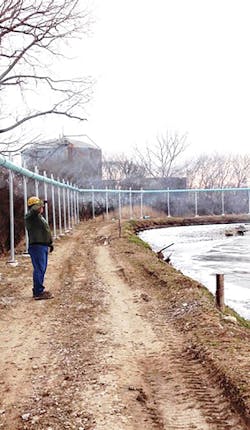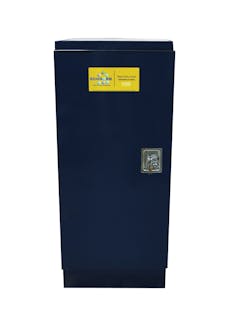Plant-Based Odor Control in Municipal Water
Aimed to convert wastewater into effluent, the process of wastewater treatment is one of the most common forms of pollution control in the United States. However, the impact various production processes have on our environment makes wastewater treatment a frequent talking point among legislatures across the country. One element of this treatment is odor control.
Plants, treatment facilities, landfills and other municipal sites are facing increased pressures to reduce odor emissions around their workers and surrounding communities, but eliminating troublesome odors from municipal facilities is easier said than done. Some facilities implement multimillion-dollar ventilation systems, which often see mixed results. Others use methods like masking agents that do little other than temporarily cover odors, providing limited relief.
The Trouble with Odor
Odor production has many characteristics — including concentration, molecular weight, and composition — that can deem whether it’s detectable or not. Because of varying characteristics, not all wastewater treatment odors are created equal. Common lingering odors like rotten eggs, ammonia, garlic, or earthy smells are caused by hydrogen sulfide (H2S), amines, sulfur dioxide, skatoles, indoles, and mercaptans. This diverse range of smells and odor sources calls for a variety of control methods.
For engineers, plant managers, and public works directors to safely and effectively eliminate odors in their facilities, an advanced approach to control is crucial.Plant-Based Solutions
Natural, plant-based odor control solutions neutralize odor molecules themselves rather than mask the smell. Through a unique mode of action, multiple delivery methods and rigorous safety qualifications, these methods are resulting in safe and complete control of odor emissions in wastewater treatment.
When dispersed into the air, the molecules of these plant-based solutions immediately bond with present odor molecules. Once bonded, the plant-based molecules absorb odor molecules, similar to water droplets being drawn into a sponge. Odor neutralization is accomplished when the odor molecules are fully enveloped in these plant-based molecules through a combination of water solubility principles and natural oil reactions.
Flexible delivery methods are another key benefit to plant-based solutions. The most common methods are atomization, vaporization and spray gel.
Atomization
Atomization is used in many industrial processes and material handling. It occurs when a concentrated odor eliminator is mixed with water to form droplets that are pumped through pipes to areas affected by odor. As the droplets are applied, they immediately come into contact with odor molecules and the neutralization process begins.
The atomization process provides a high level of control. Depending on the system design, the product volume, surface area, and spray method can all be set. Atomization systems come in the following formats:
• Explosion-proof systems
• High-pressure atomization systems
• Air atomization systems
• Fan atomization systems
• Custom-designed systems
Plant-based solutions can be applied in either high- or low-pressure systems. High-pressure systems treat odors by dispersing fine mist into the air, which treats both escaping gas emissions and surface odors. Low-pressure systems apply a solution and water mixture through a fan’s jet stream, creating a fine mist over a large area.Vaporization
Vaporization disbursement methods contain no added water, only the undiluted odor solution. Like atomization, the plant-based solution is vaporized into submicron droplets, piped through a distribution system, and dispersed to bond with odorous gases to neutralize their malodors.
Vapor delivery rates can be adaptable to many different locations and applications, even freezing temperatures. Because no water is used, vaporization allows for cost savings, enhanced cold-weather reliability, water conservation, and an enhanced eco-friendly delivery method.
Most facilities are opting for vaporization systems where ducting carries the plant-based solution in submicron form to the source of the odor, neutralizing it on contact. What’s more, these systems are virtually maintenance free.
Spray Gel
Spray gel solutions are applied directly to an odor source material to block odors from escaping. This application is ideal for:
• Sludge handling and transportation
• Open-bed waste trucks
• Working faces of landfills
• Soil remediation projects
• Solid/semi-solid materials that continuously emit odors
Ecosorb™ Spray Gel from OMI Industries is one example of a safe, earth-friendly, plant-based solution to eliminate industrial odors. A range of systems are available to evenly spray this semi-liquid material over odorous materials in trucks and storage sheds, around landfills, or as they’re released from machinery such as tillers or graders.Areas of Application
As any plant manager will attest, the process of converting wastewater into effluent contains many odorous problem areas. Plant-based solutions are ideal for multiple areas of wastewater treatment, including:
• Headworks
• Clarifiers
• Sedimentation basins
• Lift stations
• Lagoons
• Biosolids treatment
• Industrial wastewater
• Wastewater septage dumping
These processes can create various odors common to wastewater treatment, including hydrogen sulfide, ammonia, sulfur dioxide, skatoles, mercaptans, amines and indoles. These odors are effectively remedied through the use of plant-based solutions, no matter the delivery method.Attention to Safety
The government and the public will always scrutinize how wastewater is being treated and distributed into nature. Ecosorb products have been tested against EPA guidelines for human toxicity by independent laboratories. In all cases, the biochemical received the safest possible classification, specifically in cases involving:
• Acute oral toxicity
• Acute dermal toxicity
• Acute inhalation toxicity
• Primary eye irritation
• Primary dermal irritation
• Dermal sensitization
Additionally, to establish potential problems from spillage or use in an exposed water stream, Ecosorb products were tested according to U.S. EPA standards for fish toxicity and were verified to be nontoxic to marine life.
Each wastewater treatment facility’s odor situation is unique and can be as intricate as the odor composition itself. However, with safe, natural, and scientifically proven plant-based odor solutions, facility managers now have the right tools available for complete elimination of odorous emissions. WW
Dr. Laura Haupert is director of research and development at OMI Industries. Learn more at omi-industries.com.
About the Author
Dr. Laura Haupert
Dr. Laura Haupert, Ph.D. serves as Director of Research and Development at OMI Industries. For the last seven years, she’s worked to formulate, direct and coordinate all R&D of new odor control products.





